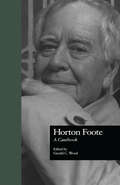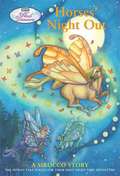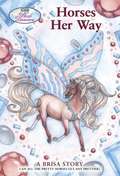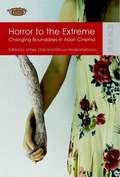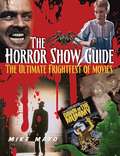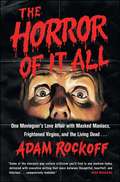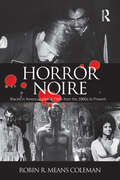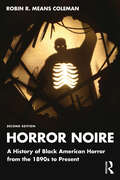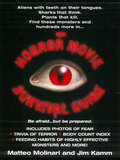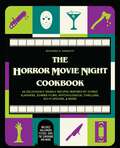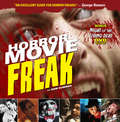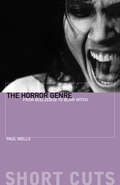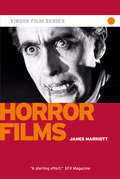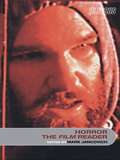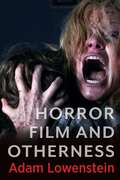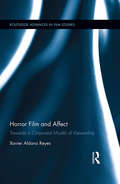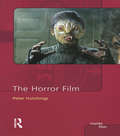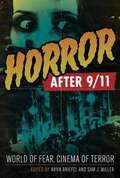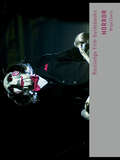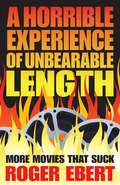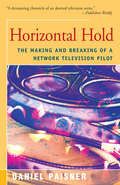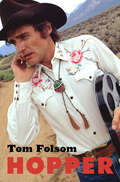- Table View
- List View
Horton Foote: A Casebook (Casebooks on Modern Dramatists #24)
by Gerald C. WoodFirst Published in 1998. Routledge is an imprint of Taylor & Francis, an informa company.
Horses' Night Out (Wind Dancers, Book #4)
by Sibley MillerMeet the Wind Dancers® Four tiny horses with shiny manes and shimmering wings burst from a puff of dandelion seeds! Four magical horses who can fly. BOOK 4: Horses' Night Out What's it like to be out in the dark of night? The three magical fillies and the one colt, who is sure he's going to love the adventure, are about to find out.
Horses Her Way (Wind Dancers, Book #6)
by Sibley MillerBeautiful Brisa, with her sunset-pink coat and blonde mane and tail, happily sets out to make the world--and everything in it, including her fellow Wind Dancers--as lovely as she is. Sounds like a plan--that only one horse can love!
Horror to the Extreme
by Jinhee Choi Mitsuyo Wada-MarcianoThis book compares production and consumption of Asian horror cinemas in different national contexts and their multidirectional dialogues with Hollywood and neighboring Asian cultures. Individual essays highlight common themes including technology, digital media, adolescent audience sensibilities, transnational co-productions, pan-Asian marketing techniques, and variations on good vs. evil evident in many Asian horror films. Contributors include Kevin Heffernan, Adam Knee, Chi-Yun Shin, Chika Kinoshita, Robert Cagle, Emilie Yeh Yueh-yu, Neda Ng Hei-tung, Hyun-suk Seo, Kyung Hyun Kim, and Robert Hyland.
The Horror Show Guide
by Mike MayoFrom atomic bombs to zealous zombies, this cinefile's guidebook reviews 1,000 of the wickedest, weirdest, and wackiest scary movies from every age of horror. With reviews on many overlooked, underappreciated gems such as Alice Sweet Alice, Daughters of Darkness, and Zombie, as well as the numerous Stephen King adaptations and modern updates such as Night of the Living Dead 3D and The Wolfman, new devotees as well as the discriminating darkcinema enthusiast will love this big, beautiful, endall, beall guide to an always popular film genre. Established directors, including Wes Craven, John Carpenter, Tim Burton, David Cronenberg, and Guillermo del Toro are given their due, as are the new generation, represented by Larry Fessenden, James Wan, Alexandre Aja, and others. In addition to the hundreds of horror film reviews, this guide includes fascinating and fun top10 lists and sidebars that are designed to lead fans to similar titles they might not have known about.
The Horror of It All
by Adam RockoffPop culture history meets blood-soaked memoir as a horror film aficionado and screenwriter recalls a life spent watching blockbuster slasher films, cult classics, and everything in between. Horror films have simultaneously captivated and terrified audiences for generations, racking up billions of dollars at the box office and infusing our nightmares with unrelenting zombies, chainsaw-wielding madmen, and myriad incarnations of ghosts, ghouls, and the devil himself. Despite evolving modes of storytelling and the fluctuating popularity of other genres, horror endures. The Horror of It All is a memoir from the front lines of the industry that dissects (and occasionally defends) the hugely popular phenomenon of scary movies. Author Adam Rockoff traces the highs and lows of the horror genre through the lens of his own obsessive fandom, born in the aisles of his local video store and nurtured with a steady diet of cable trash. From Siskel and Ebert’s crusade against slasher films to horror’s Renaissance in the wake of Scream, Rockoff mines the rich history of the genre, braiding critical analysis with his own firsthand experiences. Be afraid. Be very afraid.
Horror Noire: Blacks in American Horror Films from the 1890s to Present
by Robin R Means ColemanFrom King Kong to Candyman, the boundary-pushing genre of the horror film has always been a site for provocative explorations of race in American popular culture. In Horror Noire: Blacks in American Horror Films from 1890's to Present, Robin R. Means Coleman traces the history of notable characterizations of blackness in horror cinema, and examines key levels of black participation on screen and behind the camera. She argues that horror offers a representational space for black people to challenge the more negative, or racist, images seen in other media outlets, and to portray greater diversity within the concept of blackness itself. Horror Noire presents a unique social history of blacks in America through changing images in horror films. Throughout the text, the reader is encouraged to unpack the genre’s racialized imagery, as well as the narratives that make up popular culture’s commentary on race. Offering a comprehensive chronological survey of the genre, this book addresses a full range of black horror films, including mainstream Hollywood fare, as well as art-house films, Blaxploitation films, direct-to-DVD films, and the emerging U.S./hip-hop culture-inspired Nigerian "Nollywood" Black horror films. Horror Noire is, thus, essential reading for anyone seeking to understand how fears and anxieties about race and race relations are made manifest, and often challenged, on the silver screen.
Horror Noire: A History of Black American Horror from the 1890s to Present
by Robin R. Means ColemanFrom King Kong to Candyman, the boundary-pushing genre of horror film has always been a site for provocative explorations of race in American popular culture. This book offers a comprehensive chronological survey of Black horror from the 1890s to present day. In this second edition, Robin R. Means Coleman expands upon the history of notable characterizations of Blackness in horror cinema, with new chapters spanning the 1960s, 2000s, and 2010s to the present, and examines key levels of Black participation on screen and behind the camera. The book addresses a full range of Black horror films, including mainstream Hollywood fare, art-house films, Blaxploitation films, and U.S. hip-hop culture-inspired Nollywood films. This new edition also explores the resurgence of the Black horror genre in the last decade, examining the success of Jordan Peele’s films Get Out (2017) and Us (2019), smaller independent films such as The House Invictus (2018), and Nia DaCosta’s sequel to Candyman (2021). Means Coleman argues that horror offers a unique representational space for Black people to challenge negative or racist portrayals, and to portray greater diversity within the concept of Blackness itself. This book is essential reading for anyone seeking to understand how fears and anxieties about race and race relations are made manifest, and often challenged, on the silver screen.
The Horror Movie Survival Guide
by Jim Kamm Matteo MolinariFrom the scream of Psycho to the psycho of Scream, The Horror Movie Survival Guide is an essential source for information on the creatures and monsters that darken your daydreams and stalk your nightmares. Includes a directory of the scariest films, 30 photos of the creepiest monsters, and a body count index of the deadliest killers.
The Horror Movie Night Cookbook: 60 Deliciously Deadly Recipes Inspired by Iconic Slashers, Zombie Films, Psychological Thrillers, Sci-Fi Spooks, and More (Includes Halloween, Psycho, Jaws, The Conjuring, and More) (Gifts For Movie And Tv Lovers Ser.)
by Richard S. SargentSlay movie night with frighteningly delicious food and cocktail creations inspired by your favorite scary movies, perfect for fans of spooky season and movie buffs alike!If you're looking for kitschy Pinterest recipes like coffin-shaped cookies or zombie finger sandwiches, look elsewhere. With The Horror Movie Night Cookbook, you&’ll enjoy thoughtful and tasty food and cocktail pairings inspired by the actual content of chilling classics like Jaws, Psycho, Scream, The Conjuring, The Evil Dead, Halloween, and more of horror&’s most frightening favorites! Inside you&’ll find recipes like: Crawling Steak (Poltergeist) Campfire Sour (The Blair Witch Project) Zombie Baby Kale Salad (Dawn of the Dead) Bloody Floaties (Jaws) Alligator Bites (Crawl) The Mama&’s Boy Martini (Psycho) And more! This killer cookbook contains everything you'll need to be the star of your own horror-themed dinner party. So to quote a famous final girl, &“What are you waiting for?&”
Horror Movie Freak
by Don SumnerYou'll scream with delight while reading this fun and engaging book that discusses fright flicks all horror fans need to see to ascend to the level of a true Horror Freak -from classics (Dracula and Psycho) to modern movies (Drag Me to Hell) and lesser-known gems (Dog Soldiers). Movies are divided into various categories including Asian horror, beginners, homicidal slashers, supernatural thrillers, and zombie invasion. Features more than 130 movies, 250+ photos of movie stills and posters, and a chapter on remakes and reimaginings. The book also includes the DVD of George A. Romero's original 1968 version of "Night of the Living Dead."
The Horror Genre: From Beelzebub to Blair Witch (Short Cuts)
by Paul WellsA comprehensive introduction to the history and key themes of the genre. The main issues and debates raised by horror, and the approaches and theories that have been applied to horror texts are all featured. In addressing the evolution of the horror film in social and historical context, Paul Wells explores how it has reflected and commented upon particular historical periods, and asks how it may respond to the new millennium by citing recent innovations in the genre's development, such as the "urban myth" narrative underpinning Candyman and The Blair Witch Project. Over 300 films are treated, all of which are featured in the filmography.
Horror Films - Virgin Film
by James MarriottFrom the Slick horror of Alien, Scream and The Ring and the cult classics Dracula, Frankenstein and The Mummy to the slasher icons Jason, Freddy and Leatherface, horror just won’t stay dead. The genre has earned its place in the moviegoing psyche, with many of the key films spawning numerous copycats. But what are the 20 most influential horror films of all time? And what made them so important?James Marriott give an incisive account of the definitive works (and the most influential directors) of the genre over the last 80 years – from silent Expressionist classics to Japanese wraiths. The book reveals the inspiration behind each film and examines the choice of director, cast, soundtrack and marketing. Marriott analyzes the critical reception of each film and examines the subsequent impact on the industry and the public worldwide.
Horror, The Film Reader (In Focus: Routledge Film Readers)
by Mark JancovichHorror, The Film Reader brings together key articles to provide a comprehensive resource for students of horror cinema. Mark Jancovich's introduction traces the development of horror film from The Cabinet of Dr. Caligari to The Blair Witch Project, and outlines the main critical debates. Combining classic and recent articles, each section explores a central issue of horror film, and features an editor's introduction outlining the context of debates.
Horror Film and Otherness (Film and Culture Series)
by Adam LowensteinWhat do horror films reveal about social difference in the everyday world? Criticism of the genre often relies on a dichotomy between monstrosity and normality, in which unearthly creatures and deranged killers are metaphors for society’s fear of the “others” that threaten the “normal.” The monstrous other might represent women, Jews, or Blacks, as well as Indigenous, queer, poor, elderly, or disabled people. The horror film’s depiction of such minorities can be sympathetic to their exclusion or complicit in their oppression, but ultimately, these images are understood to stand in for the others that the majority dreads and marginalizes.Adam Lowenstein offers a new account of horror and why it matters for understanding social otherness. He argues that horror films reveal how the category of the other is not fixed. Instead, the genre captures ongoing metamorphoses across “normal” self and “monstrous” other. This “transformative otherness” confronts viewers with the other’s experience—and challenges us to recognize that we are all vulnerable to becoming or being seen as the other. Instead of settling into comforting certainties regarding monstrosity and normality, horror exposes the ongoing struggle to acknowledge self and other as fundamentally intertwined.Horror Film and Otherness features new interpretations of landmark films by directors including Tobe Hooper, George A. Romero, John Carpenter, David Cronenberg, Stephanie Rothman, Jennifer Kent, Marina de Van, and Jordan Peele. Through close analysis of their engagement with different forms of otherness, this book provides new perspectives on horror’s significance for culture, politics, and art.
Horror Film and Affect: Towards a Corporeal Model of Viewership (Routledge Advances in Film Studies)
by Xavier Aldana ReyesThis book brings together various theoretical approaches to Horror that have received consistent academic attention since the 1990s – abjection, disgust, cognition, phenomenology, pain studies – to make a significant contribution to the study of fictional moving images of mutilation and the ways in which human bodies are affected by those on the screen on three levels: representationally, emotionally and somatically. Aldana Reyes reads Horror viewership as eminently carnal, and seeks to articulate the need for an alternative model that understands the experience of feeling under corporeal threat as the genre’s main descriptor. Using recent, post-millennial examples throughout, the book also offers case studies of key films such as Hostel, [REC], Martyrs or Ginger Snaps, and considers contemporary Horror strands such as found footage or 3D Horror.
The Horror Film
by Peter HutchingsThe Horror Film is an in-depth exploration of one of the most consistently popular, but also most disreputable, of all the mainstream film genres. Since the early 1930s there has never been a time when horror films were not being produced in substantial numbers somewhere in the world and never a time when they were not being criticised, censored or banned. The Horror Film engages with the key issues raised by this most contentious of genres. It considers the reasons for horror's disreputability and seeks to explain why despite this horror has been so successful. Where precisely does the appeal of horror lie? An extended introductory chapter identifies what it is about horror that makes the genre so difficult to define. The chapter then maps out the historical development of the horror genre, paying particular attention to the international breadth and variety of horror production, with reference to films made in the United States, Britain, Italy, Spain and elsewhere. Subsequent chapters explore: The role of monsters, focusing on the vampire and the serial killer. The usefulness (and limitations) of psychological approaches to horror. The horror audience: what kind of people like horror (and what do other people think of them)? Gender, race and class in horror: how do horror films such as Bride of Frankenstein, The Texas Chainsaw Massacre and Blade relate to the social and political realities within which they are produced? Sound and horror: in what ways has sound contributed to the development of horror? Performance in horror: how have performers conveyed fear and terror throughout horror's history? 1970s horror: was this the golden age of horror production? Slashers and post-slashers: from Halloween to Scream and beyond. The Horror Film throws new light on some well-known horror films but also introduces the reader to examples of noteworthy but more obscure horror work. A final section provides a guide to further reading and an extensive bibliography. Accessibly written, The Horror Film is a lively and informative account of the genre that will appeal to students of cinema, film teachers and researchers, and horror lovers everywhere.
Horror after 9/11
by Aviva Briefel Sam J. MillerHorror films have exploded in popularity since the tragic events of September 11, 2001, many of them breaking box-office records and generating broad public discourse. These films have attracted A-list talent and earned award nods, while at the same time becoming darker, more disturbing, and increasingly apocalyptic. Why has horror suddenly become more popular, and what does this say about us? What do specific horror films and trends convey about American society in the wake of events so horrific that many pundits initially predicted the death of the genre? How could American audiences, after tasting real horror, want to consume images of violence on screen? Horror after 9/11 represents the first major exploration of the horror genre through the lens of 9/11 and the subsequent transformation of American and global society. Films discussed include the Twilight saga; the Saw series; Hostel; Cloverfield; 28 Days Later; remakes of The Texas Chainsaw Massacre, Dawn of the Dead, and The Hills Have Eyes; and many more. The contributors analyze recent trends in the horror genre, including the rise of ‘torture porn,’ the big-budget remakes of classic horror films, the reinvention of traditional monsters such as vampires and zombies, and a new awareness of visual technologies as sites of horror in themselves. The essays examine the allegorical role that the horror film has held in the last ten years, and the ways that it has been translating and reinterpreting the discourses and images of terror into its own cinematic language.
Horror (Routledge Film Guidebooks)
by Brigid CherryHorror cinema is a hugely successful, but at the same time culturally illicit genre that spans the history of cinema. It continues to flourish with recent cycles of supernatural horror and torture porn that span the full range of horror styles and aesthetics. It is enjoyed by audiences everywhere, but also seen as a malign influence by others. In this Routledge Film Guidebook, audience researcher and film scholar Brigid Cherry provides a comprehensive overview of the horror film and explores how the genre works. Examining the way horror films create images of gore and the uncanny through film technology and effects, Cherry provides an account of the way cinematic and stylistic devices create responses of terror and disgust in the viewer. Horror examines the way these films construct psychological and cognitive responses and how they speak to audiences on an intimate personal level, addressing their innermost fears and desires. Cherry further explores the role of horror cinema in society and culture, looking at how it represents various identity groups and engages with social anxieties, and examining the way horror sees, and is seen by, society.
A Horrible Experience of Unbearable Length: More Movies That Suck
by Roger EbertMore of the Pulitzer Prize–winning film critic’s most scathing reviews.A Horrible Experience of Unbearable Length collects more than 200 of his reviews from 2006 to 2012 in which he gave movies two stars or fewer. Known for his fair-minded and well-written film reviews, Roger is at his razor-sharp humorous best when skewering bad movies. Consider this opener for the one-star Your Highness:“Your Highness is a juvenile excrescence that feels like the work of 11-year-old boys in love with dungeons, dragons, warrior women, pot, boobs, and four-letter words. That this is the work of David Gordon Green beggars the imagination. One of its heroes wears the penis of a minotaur on a string around his neck. I hate it when that happens.”And finally, the inspiration for the title of this book, the one-star Transformers: Revenge of the Fallen:“Transformers: Revenge of the Fallen is a horrible experience of unbearable length, briefly punctuated by three or four amusing moments. One of these involves a doglike robot humping the leg of the heroine. If you want to save yourself the ticket price, go into the kitchen, cue up a male choir singing the music of hell, and get a kid to start banging pots and pans together. Then close your eyes and use your imagination.”Roger Ebert’s I Hated, Hated, Hated This Movie and Your Movie Sucks, which gathered some of his most scathing reviews, were bestsellers. This collection continues the tradition, reviewing not only movies that were at the bottom of the barrel, but also movies that he found underneath the barrel. Movie buffs and humor lovers alike will relish this treasury of movies so bad that you may just want to see them for a good laugh!
A Horrible Experience of Unbearable Length: More Movies That Suck
by Roger EbertMore of the Pulitzer Prize–winning film critic’s most scathing reviews.A Horrible Experience of Unbearable Length collects more than 200 of his reviews from 2006 to 2012 in which he gave movies two stars or fewer. Known for his fair-minded and well-written film reviews, Roger is at his razor-sharp humorous best when skewering bad movies. Consider this opener for the one-star Your Highness:“Your Highness is a juvenile excrescence that feels like the work of 11-year-old boys in love with dungeons, dragons, warrior women, pot, boobs, and four-letter words. That this is the work of David Gordon Green beggars the imagination. One of its heroes wears the penis of a minotaur on a string around his neck. I hate it when that happens.”And finally, the inspiration for the title of this book, the one-star Transformers: Revenge of the Fallen:“Transformers: Revenge of the Fallen is a horrible experience of unbearable length, briefly punctuated by three or four amusing moments. One of these involves a doglike robot humping the leg of the heroine. If you want to save yourself the ticket price, go into the kitchen, cue up a male choir singing the music of hell, and get a kid to start banging pots and pans together. Then close your eyes and use your imagination.”Roger Ebert’s I Hated, Hated, Hated This Movie and Your Movie Sucks, which gathered some of his most scathing reviews, were bestsellers. This collection continues the tradition, reviewing not only movies that were at the bottom of the barrel, but also movies that he found underneath the barrel. Movie buffs and humor lovers alike will relish this treasury of movies so bad that you may just want to see them for a good laugh!
Horowitz: A Biography of Vladimir Horowitz
by Glenn PlaskinWell-researched, richly evocative and provocative biography of the legendary Russian pianist.
Hornblower's Ships: Their History and Their Models
by Martin SavilleHornblower stories was one of the most expensive series ever made for television. Millions went into the lavish special effects to recreate the epic sea battles featuring eleven fully working scale models.
Horizontal Hold: The Making and Breaking of a Network Television Pilot
by Daniel PaisnerAbsurdly funny, trenchant, and provocative, this outside-looking-in account of the stillbirth of one particular television series is a must read for every serious and not-so-serious television viewer.
Hopper
by Tom FolsomJames Dean to Hopper "I saw what you did today. Today you were great. " Jack Nicholson to Hopper "We're geniuses, you know that? Isn't it great to be a genius?" The chopper-riding hippie outlaw in Easy Rider. The prophetic madman in the jungle in Apocalypse Now. The terrifying psychopath in Blue Velvet. The kid gone wrong in Rebel Without a Cause. The actor taken under the wing of James Dean who longed to be the next Orson Welles. The hell-raising director who revolutionized Hollywood. An enigmatic man from Dodge City, Kansas, on an endless quest to realize the American Dream. Dennis Hopper has been described as a rebel, an icon, an addict plagued by demons, and one of the most important champions of the pop-art movement. Friend to Warhol, muse to David Lynch, mentor to Sean Penn, champion of Ice-T, Dennis Hopper built a career that was a half-century of rebellion waged at the edge of American popular culture. Tom Folsom's Hopper is a wild ride through Dennis's many lives. Featuring hundreds of interviews with Hopper's fellow actors, artists, musicians, and residents of Taos, New Mexico (where he spent much of his most manic time), as well as his ex-wives and many other people who knew him, Hopper takes you on an extraordinary-and sometimes troubling-journey. From Dennis's early days with his grandparents on a dusty farm in Kansas, where he watched trains go by on their way to Los Angeles, to his formative time in Hollywood as one of a bright new crop of actors straddling the edge of the studio system, to the rebellious 1960s and the start of the independent film movement, to the drug-addled 1970s and beyond, when Hopper staged one of the greatest Hollywood comebacks of all time-Tom Folsom has crafted a biography as unconventional as Dennis Hopper himself.
